________________
Prakrit Verses in Sanskrit Works on Poetics
of the Suvela mountain) 10 Kämini-kelih (The gaieties of love of the young women of Lanka) 11 Mãyottamängam (The exhibition of the severed head of Rāma by magic and the lamentation of Sītā and Trijatā's consolatory speech) 12 Sainya-sanghattaḥ (The battle of the two armies of the Vanaras and the Rākṣasas 13 Dvandva-sangrāmaḥ (Single Combats between leaders of the Vanaras and the Rākşasas) 14 Rakşo-Vikşobhaḥ (The convulsions of the Rākşasas) and 15 Sītā-samprāptih (Reunion with Sītā after the slaying of Rāvana).
The Setubandha is the only extant Mahākávya written in Prakrit. Its affinity to the Sanskrit Mahākāvya is one of the main causes of its popularity through the centuries, 32
(e. and f.) Vākpatirăja's Mahumahaviaa (Sk : Madhumathavijaya) and Gaüdavaho (Sk Gaudavadha) — these two poems were composed in the first half of the eighth century A.D. Of these two kavyas, Mahumahaviaa is now lost. Vākpati himself refers to this work in his Gaiļavaho. “How can my robust (flowery) language (employed) in the Madhumathavijaya shrink to the size of a (compact) bud ? (But then) the later blossoming of the wild creepers is much thinner and softer than its first."33
Abhinavagupta while commenting on Dhvanyāloka34 cites the following gātha as: forming a part of Pāñcajanya's speech : “O, (Madhu-matha (-mathana, Vişņu), you
ce as a boar carried with ease the entire terrestrial globe on the tip of your tusk, then how is it that today you find even this (very light) ornament of
32) For its popularity and its influence on writers on Sanskrit poetics vide infra
"Praise of Prakrit Poets” and “Influence of Prakrit Poetry on Sanskrit Writers
on Poetics." 33) 466-f3137-93TIT 9737T 16 UH HOMO GARI
पढमकुसुमाहि तलिणं पच्छा कुसुमं वणलआण || [ मधुमथ [न]-विजयप्रयुक्ता वाक् कथं नाम मुकुलयत्वस्मिन् । berrirati quy TAHIM ]
- Gaüdavaho-60 34) JERIT Hymenout naureling
– Dhvanyaloka II.15, P. 345




